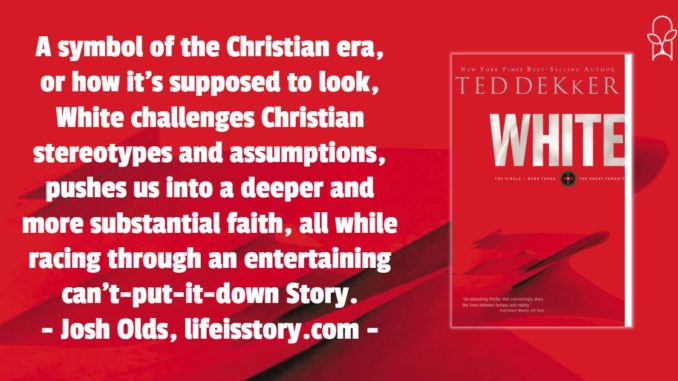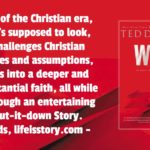
Also by this author: The Promise, The Drummer Boy, Sinner, Green, The Dream Traveler's Quest, Into the Book of Light, The Curse of Shadownman, The Garden and the Serpent, The Final Judgment, Millie Maven and the Bronze Medallion
Series: The Circle Series #3
Published by Thomas Nelson on October 2004
Genres: Fiction, Christian, Fantasy, Suspense
Buy on Amazon
Goodreads

Time Is Running Out In Two Realities.
In one world, a lethal virus threatens to destroy all life as scientists and governments scramble to find an antidote. In the other, a forbidden love could forever destroy the ragtag resistance known as The Circle.
Thomas can bridge both worlds, but he is quickly realizing that he may not be able to save either.
In this mind-bending adventure, Thomas must find a way to rewrite history as he navigates a whirlwind of emotions and events surrounding a pending apocalypse.
The fate of two worlds comes down to one man's choice--and it is a most unlikely choice indeed. Life. Death. Love. Nothing is as it seems. Yet all will forever be transformed by the decisions of one man in the final hours of the Great Pursuit.
White begins seamlessly where Red, left off—with the Raison Strain beginning to wreak its havoc with no known cure in sight in one world, while in another world the Circle copes with a radical new teaching and its effects on their life. Indeed, as an aside, it seems to have been a conscious decision by Dekker and his publisher, Thomas Nelson, to have not stopped on any too-dramatic precipice. Black could have stopped with the Shataiki overrunning the forest. The end of Red could have been the death of Justin. The story continues on just enough that it feels like the beginning of each novel is partially into the next chapter of the story. While it does make for a bit more of an awkward transition, it’s a good decision. This trilogy was meant to be read as one story. The books all released a few months apart from each other. This is the final (or…you know…not so final) part of the story.
While Black chronicles the birth of evil and Red its redemption from it, White is the story of the great pursuit—God’s romance of his people. A symbol of the Christian era, or how it’s supposed to look, White challenges Christian stereotypes and assumptions, pushes us into a deeper and more substantial faith, all while racing through an entertaining can’t-put-it-down Story. Of the three storylines in Other Earth, White is the weakest. While the allegory of the first two novels were strikingly clear, allegorizing the church age is something altogether more complex. Dekker chooses to do this by narrowing the storyline from a grand, worldwide allegory to one that’s intensely personal.
At the crux of the story in Other Earth is Thomas Hunter’s unlikely romance with a forbidden love. Forbidden because she is Chelise, daughter of Qurong the leader of the Horde, and because she herself has not drowned in the waters of Elyon. It seems scandalous that Thomas should fall in love with the Horde, but wasn’t that really what Elyon had done with them? White personalizes the Great Romance that serves as the grand backdrop for the whole Trilogy by playing it out in the lives of Thomas and Chelise. This is a story that Dekker’s done before in When Heaven Weeps and while the backdrop of Other Earth provides a fresh take, the allegory feels more forced. This could have been a great way to broaden the world as The Circle moves from their “Jerusalem” into the uttermost parts of Other Earth. Instead the story narrows into a rehashed romance plot when the readers (meaning myself) still haven’t gotten over the death of Rachelle.
In Real Earth, things have reached a breaking point. The world is going to die because of an airborne virus. People are panicking. Everyone is taking this seriously. There are protests in front of the White House. It’s maybe the largest fiction in the book, because in 2022 we all know that a good part of the population wouldn’t take the virus seriously. But anyway…The series so far has set up that certain things can transfer between the worlds and that blood—specifically, Thomas’s blood—connects the worlds. Thomas’s blood, then, becomes the needed antivirus for the Raison Strain. This time, the redemptive imagery comes in Real Earth. Thomas Hunter, having been washed in the blood of Justin in Red now follows Justin in death to save others.
There’s a particular scene that made me choke up—and I’ve read these books a dozen times and listened to them a half-dozen. The President offers Thomas a way to live, but it will cost maybe a billion lives. The President assures him that they can at least save North America and Hunter cuts him off. “No. He gave me life for this…History pivots on this sacrifice.” For two books Real Earth had been overshadowed by Other Earth. In White, Real Earth is the superior story. Following Justin, he lays down his life.
The storyline in Other Earth is a lot more open-ended. Thomas is still alive there and unable to dream. Justin returns but not returns returns like we’re still following redemptive history and this is the End Times. More like the trilogy ends on Pentecost. Justin reveals himself, along with a host of white lions and Roush and they celebrate the marriage of Thomas and Chelise. I get why Dekker ended it the way that he did, but I wonder if a Green-style apocalypse would have rounded out the narrative even better. I don’t know what that would have looked like, as 2009’s Green draws from a whole host of as-yet-unwritten-in-2004 Dekker lore, but it would have been a better literary conclusion in terms of parallelism—Real Earth is saved temporarily while Other Earth is destroyed (or saved?) ultimately.
Dekker has moved on in his writing to many other things, but this…I think these novels will always stand high and above anything else he writes. Not because his other novels aren’t quality, but because nothing can compare with how this Trilogy has impacted me and millions of others. Without this series, I wonder if Ted would have had the career he did. Genesis was the first book Ted ever wrote and it spent many years in a drawer before it was reworked into Black. Most authors’ first attempts at a story are better left in the box, but this one proved to be revolutionary.


Be the first to comment